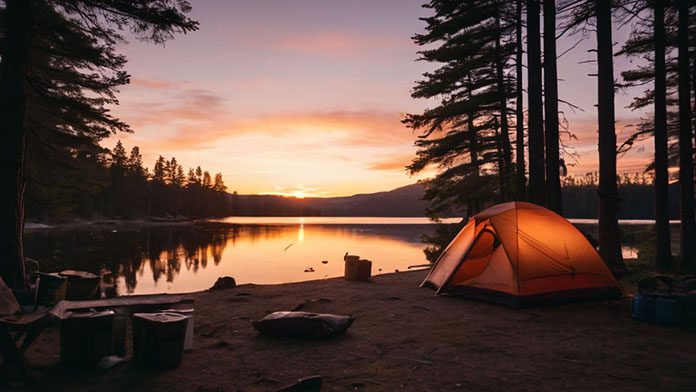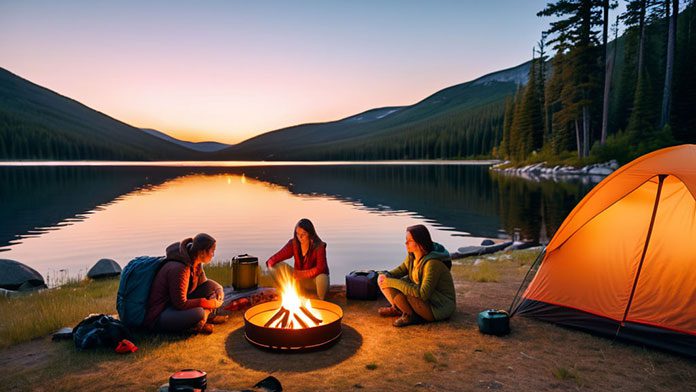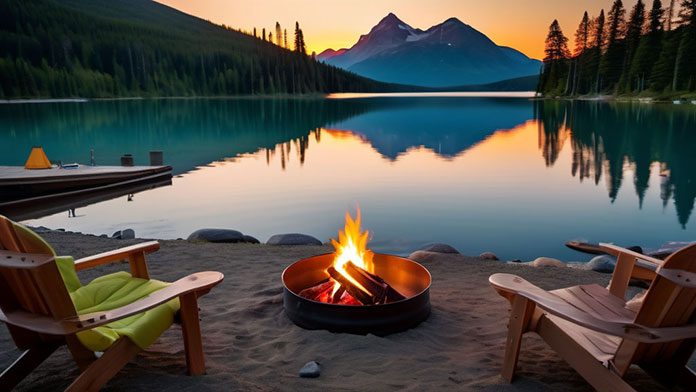Are you ready to embark on a wilderness adventure? Before you dive into the great outdoors, equip yourself with these 7 essential tips for preparing for camping.
Picture yourself surrounded by towering trees, a crackling campfire, and a starry sky above.
From choosing the perfect campsite to packing for all weather conditions, this article will guide you through the necessary steps to ensure a successful and enjoyable camping trip.
So, grab your gear and get ready to experience nature like never before!
Table of Contents

Related Video: "Camping 101 for Beginners | Useful Knowledge" by Useful Knowledge
Main Points
– Consider the type of camping experience you want (secluded or social).
– Pack essential camping gear such as a tent, sleeping bag, and cooking equipment.
– Invest in high-quality gear suitable for the specific terrain and weather conditions.
– Practice Leave No Trace principles and clean up the campsite to minimize environmental impact.
Choosing the Right Campsite

When choosing a campsite, consider your specific needs and preferences to ensure an enjoyable camping experience. Finding the perfect campsite is essential for a successful camping trip. The location you choose can greatly impact your overall experience, so it’s important to take the time to consider various factors before making a decision.
Firstly, think about the type of camping experience you want. Do you prefer a more secluded and quiet spot, or do you enjoy being closer to amenities and other campers? If you’re looking for tranquility, consider campsites that are off the beaten path, away from popular tourist areas. On the other hand, if you enjoy socializing and meeting new people, look for campsites that offer communal areas or planned activities.
Next, consider the amenities and facilities that are important to you. Are you looking for a campsite with showers and toilets, or are you comfortable with more basic facilities? Think about whether you need access to electricity, water, or a picnic table. These considerations will help you narrow down your options and find a campsite that meets your specific needs.
Lastly, consider the surroundings and natural features of the campsite. Do you prefer a campsite near a lake, river, or hiking trails? Are you looking for a campsite with scenic views or wildlife sightings? Take the time to research the area and read reviews from previous campers to get a better understanding of what to expect.
Essential Camping Gear Checklist

Now that you’ve chosen the perfect campsite, it’s time to take a look at the essential camping gear checklist. Whether you’re a seasoned camper or a beginner, having the right gear is crucial for a successful outdoor adventure.
From must-haves like a tent, sleeping bag, and cooking equipment, to packing for a wilderness adventure with hiking gear and survival essentials, this checklist will ensure you’re well-prepared for any camping trip.
Must-Have Camping Gear
Make sure you have all the essential camping gear on your checklist before heading out. Camping gear plays a crucial role in ensuring a comfortable and enjoyable camping experience. Along with camping food and camping accessories, having the right gear is essential. Here is a checklist of must-have camping gear:
| Gear | Purpose |
|---|---|
| Tent | Provides shelter and protection from the elements |
| Sleeping bags | Keeps you warm and cozy during the night |
| Camping stove | Allows you to cook meals and boil water |
| Headlamp | Provides hands-free lighting in the dark |
| First aid kit | Essential for treating minor injuries and ailments |
Having these items will make your camping trip much more enjoyable and stress-free. Additionally, don’t forget to pack other essentials such as a camping chair, cooler, camping cookware, and a camping lantern. With the right gear, you’ll be well-prepared to tackle any camping adventure.
Packing for Wilderness Adventure
Pack the essential camping gear for your wilderness adventure to ensure a successful and enjoyable trip. Here are three items you should include in your packing checklist:
1. Tent: Invest in a high-quality tent that’s suitable for the terrain and weather conditions of your camping destination. Look for features like durability, waterproofing, and ease of setup.
2. Sleeping bag and sleeping pad: A comfortable and warm sleeping bag is crucial for a good night’s sleep in the wilderness. Pair it with a sleeping pad to provide insulation and cushioning from the ground. Opt for lightweight and compact options for easy transport.
3. Cooking equipment: Pack a portable stove, cookware, and utensils for preparing meals in the wilderness. Consider lightweight and space-saving options to minimize the weight and bulk of your camping gear.
These wilderness camping tips and camping packing hacks will help you stay organized and prepared for your outdoor adventure. Happy camping!
Essential Outdoor Equipment
To have a successful camping trip, it’s important to bring along the essential outdoor equipment.
When it comes to camping cooking, a portable stove or grill is a must-have. These compact cooking appliances allow you to prepare hot meals and beverages in the great outdoors. Don’t forget to pack cookware like pots, pans, and utensils, as well as a cooler to keep your food fresh.
As for sleeping essentials, a good quality tent is essential to protect you from the elements. Make sure to also bring sleeping bags or air mattresses for a comfortable night’s sleep. Don’t forget pillows, blankets, and extra layers for warmth.
With the right camping cooking and sleeping essentials, you’ll be well-prepared for a memorable camping experience.
Planning Meals and Snacks

When planning meals and snacks for your camping trip, consider the time required for preparation and storage. It’s important to have a meal plan in place to ensure you have enough food for the duration of your trip. Here are some essential tips for meal planning and selecting camping snacks:
1. Keep it simple: Opt for meals that are easy to prepare and require minimal cooking time. One-pot meals, such as chili or stir-fry, are great options. Pre-cut and marinate meats or veggies before your trip to save time.
2. Pack non-perishable snacks: Choose snacks that don’t require refrigeration and can withstand the outdoor conditions. Granola bars, trail mix, beef jerky, and dried fruits are excellent choices. They provide energy and are convenient to carry around.
3. Consider dietary restrictions: If you or anyone in your camping group has dietary restrictions or allergies, plan meals that accommodate those needs. Research and prepare alternative options to ensure everyone is well-fed and satisfied.
By following these meal planning tips and selecting the right camping snacks, you can spend less time preparing meals and more time enjoying the great outdoors. Remember to pack enough food to sustain you throughout your camping adventure, and don’t forget to bring a cooler to keep perishable items fresh.
Happy camping and bon appétit!
Packing for All Weather Conditions
When preparing for camping, it’s important to pack for all weather conditions. One key tip is to layer your clothing, so that you can add or remove layers as the temperature changes throughout the day.
Pack versatile clothing items that can be easily mixed and matched, allowing you to adapt to different weather conditions without overpacking.
Layering for Changing Weather
You should always pack clothing layers for all weather conditions when preparing for camping. Layering techniques allow you to adjust your clothing according to the changing weather, keeping you comfortable and protected throughout your camping trip. Here are three key items to consider when packing for all weather conditions:
1. Base layers: These are the foundation of your layering system. Choose moisture-wicking and insulating materials like merino wool or synthetic fabrics. Base layers help regulate your body temperature by keeping you dry and warm.
2. Mid-layers: These provide insulation and can be easily added or removed depending on the weather. Fleece jackets or down vests are great options. They trap heat and provide extra warmth when needed.
3. Outer layers: These are your protective shell against rain, wind, and snow. Look for waterproof and breathable jackets or outer shells. They’ll keep you dry and shielded from the elements.
Pack Versatile Clothing Items
To ensure you’re prepared for all weather conditions while camping, it’s important to pack versatile clothing items that can adapt to any situation.
When it comes to choosing versatile clothing options for camping, consider items that can be layered easily and provide both warmth and breathability.
Opt for moisture-wicking base layers that can keep you dry and comfortable in hot weather, while also providing insulation in colder temperatures.
Pack lightweight, quick-drying shirts and pants that can be easily layered with warmer clothing when needed.
Don’t forget to include a waterproof jacket or poncho to protect yourself from rain or unexpected showers.
Additionally, pack accessories like hats, gloves, and scarves that can provide extra warmth when the temperature drops.
Setting Up the Campsite
Before starting your camping trip, it’s important to familiarize yourself with the process of setting up the campsite. This will ensure that you have a safe and organized space to enjoy your outdoor adventure.
Here are three essential tips to help you set up your campsite:
1. Campfire Safety: One of the most important aspects of setting up your campsite is ensuring campfire safety. Find a designated fire pit or clear an area for your campfire. Keep a bucket of water nearby to extinguish the fire completely before leaving. Remember to never leave the fire unattended and always supervise children around the campfire.
2. Campsite Organization: A well-organized campsite will make your camping experience much more enjoyable. Set up your tent on level ground, away from any potential hazards like dead trees or rocks. Create designated areas for cooking, eating, and relaxation. Use bins or storage containers to keep your gear organized and easily accessible.
3. Leave No Trace: When setting up your campsite, always practice Leave No Trace principles. This means packing out all your trash, minimizing your impact on the environment, and respecting the natural beauty of the area. Leave your campsite cleaner than you found it, so future campers can enjoy it as well.
By following these tips, you’ll be well-prepared to set up a safe and organized campsite for your camping trip.
Happy camping!
Safety Tips for a Successful Trip
Ensuring campfire safety, organizing your campsite, and practicing Leave No Trace principles are crucial for a successful and safe camping trip. When it comes to campfire safety, always remember to keep a safe distance from the flames and never leave it unattended. Use a fire ring or designated fire pit if available, and make sure to extinguish the fire completely before leaving.
To organize your campsite effectively, consider using a table to keep things neat and accessible. In addition, a well-organized campsite reduces the risk of tripping and falling. Here is a simple table to help you stay organized:
| Category | Items | Location |
| Cooking | Stove, utensils, pots | On the table |
| Food | Cooler, non-perishables | In the cooler |
| Sleeping Gear | Tent, sleeping bags | In the tent |
| Personal Items | Clothes, toiletries | In your backpack |
Lastly, it is important to be prepared for wildlife encounters. While camping, you may come across various animals, some of which can be dangerous. To minimize the risk, store food securely in bear-resistant containers or hang it from a tree branch. Avoid leaving any food scraps or garbage outside your campsite. It is also wise to carry bear spray and know how to use it in case of an emergency.
Leave No Trace: Campsite Clean-Up Guidelines
When you’re finished camping, make sure to clean up your campsite using the principles of Leave No Trace. Following campsite etiquette and minimizing your environmental impact is crucial for preserving the natural beauty of the outdoors.
Here are three guidelines to help you clean up your campsite effectively:
1. Pack out all your trash: Take the time to gather and properly dispose of all your garbage. This includes food wrappers, empty bottles, and any other waste you may have generated during your stay. Leaving trash behind not only damages the environment but also poses a threat to wildlife.
2. Leave nature as you found it: Avoid disturbing natural elements such as rocks, plants, and trees. Refrain from digging trenches, cutting branches, or altering the landscape in any way. By leaving nature untouched, you allow other campers and future generations to enjoy the same unspoiled beauty.
- Minimize fire impact: If you’d a campfire, ensure it’s completely extinguished. Spread out the ashes and cover them with dirt to prevent any remaining embers from reigniting. Additionally, scatter any leftover firewood so that it can decompose naturally.
Frequently Asked Questions
What Are Some Common Camping Activities to Keep Children Entertained?
To keep your children entertained during camping, you can engage them in various camping activities and games. These activities and games will make their camping experience more enjoyable and memorable.
Is It Necessary to Bring a First Aid Kit and What Should Be Included in It?
You should always bring a first aid kit when camping. It's essential for any emergencies or injuries. Make sure it includes bandages, antiseptic wipes, pain relievers, and any necessary medications.
Are There Any Restrictions or Permits Required for Camping in Certain Areas?
Before venturing into the wilderness, be aware of any restrictions or permits needed for camping in certain areas. Familiarize yourself with the regulations to ensure a safe and enjoyable experience.


